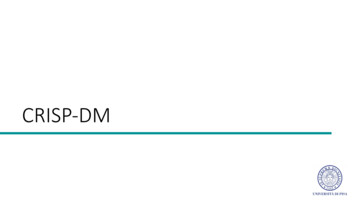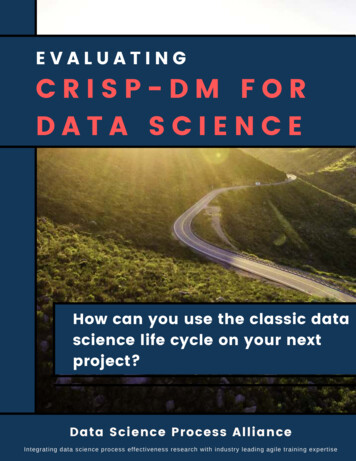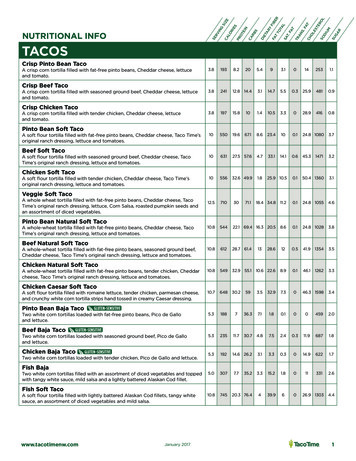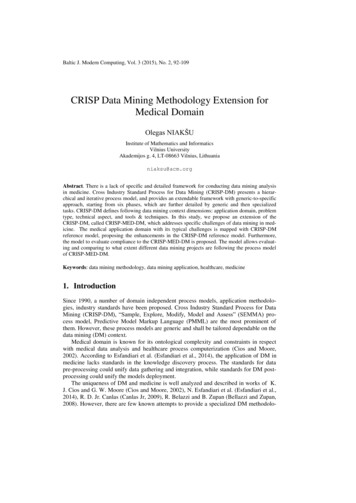
Transcription
CRISP-DM
What is CRISP-DM? It stays for CRoss-Industry Standard Process for Data Mining A methodology that provides a structured approach to planninga data mining project An open standard process model that describes commonapproaches used by data mining experts Introduced in 1996 and widely adopted IBM incorporated the CRISP-Dm model in its SPSS Modeler product
Why Should There be a Standard Process? The data mining process must be reliable and repeatable by peoplewith little data mining background.
Why Should There be a Standard Process? Framework for recording experience Allows projects to be replicatedAid to project planning and management“Comfort factor” for new adoptersDemonstrates maturity of Data MiningEncourage best practices and help to obtain better results
Properties of the methodology Non-proprietary Application/Industry neutral Tool neutral Focus on business issues As well as technical analysis Framework for guidance Experience base Templates for Analysis
Six PhasesA set of guardrails to help you plan,organize, and implement your datamining projectCRISP-DM breaks down the life cycle of adata mining project into six phases.
Phases & Tasks
Phase 1 - Business Understanding Statement of Business Objective States goal in business terminology Statement of Data Mining objective States objectives in technical terms Statement of Success CriteriaGOAL: Focuses on understanding the project objectives and requirements from abusiness perspective, then converting this knowledge into a data mining problemdefinition and a preliminary plan designed to achieve the objectivesQuestions: What the client really wants to accomplish? Which are important factors (constraints, competing objectives, . )? constraints, competing objectives to be balances
Phase 1 - Business Understanding Determine business objectives Thoroughly understand, from abusiness perspective, what theclient really wants to accomplish Describe the primaryobjective from a businessperspective Uncover important factors, at thebeginning, that can influence theoutcome of the projectExamplePrimary goal keep current customers by predicting when theyare prone to move to a competitorRelated Business Questions Does the channel used affect whethercustomers stay or go? Will lower ATM fees significantly reduce thenumber of high-value customers who leave?
Phase 1 - Business Understanding - Determinebusiness objectives Determine business objectives Key persons and their roles? Is there a steering committee. Internal sponsor (financial, domain expert) Business units impacted by the project (sales, finance,.) ? Business success criteria and who assesses it? Users’ needs and expectations Describe problem in general terms. Business questions, Expected benefits.
Phase 1 - Business Understanding - Assess situation Inventory of resources – List the resources available to the project including: Personnel (business experts, data experts, technical support, data mining experts)Data (fixed extracts, access to live, warehoused, or operational data)Computing resources (hardware platforms)Software (data mining tools, other relevant software) Requirements, assumptions and constraints Schedule of completionRequired comprehensibility and quality of resultsAny data security concerns as well as any legal issuesMake sure that you are allowed to use the dataList the assumptions made by the project (non-verifiable and verifiable by DM) Risks List the risks or events that might delay the project or cause it to fail. List thecorresponding contingency plans – what action will you take if these risks or eventstake place? Costs and benefits Construct a cost-benefit analysis for the project which compares the costs of theproject with the potential benefits to the business if it is successful.
Phase 1 - Business Understanding – DM goals A business goal states objectives in business terminology A data mining goal states objectives in technical termsA business goal: “Increase catalog sales to existing customers.”A data mining goal: “Predict how many widgets a customer will buy,given their purchases over the past three years, demographicinformation (age, salary, city) and the price of the item.” Specify data mining problem type (e.g., classification, prediction andclustering) Specify criteria for model assessment – criteria of assessment e.g.,accuracy of predictive task
Phase 1 - Business Understanding – Project Plan Describe the intended plan for achieving the data mining goals andthereby achieving the business goals. The plan should specify the anticipated set of steps to be performedduring the rest of the project including an initial selection of tools andtechniques Project Plan: Stages of the project with duration, resources, input, output and dependenciesAnalysis of dependencies between time schedule and risksIdentify actions and recommendations if the risks are manifestedDecide the valuation strategy will be used in the evaluation phase This document is dynamic because at the end of phase there is a review of the progress and achievements and the plan should be updated
Phase 1 - Business Understanding – Project Plan Initial assessment of tools and techniques select a data mining tool that supports various methods for different stages ofthe process. It is important to assess tools and techniques early in the process since theselection of tools and techniques may influence the entire project.
Phase 2. Data Understanding Acquire the data Document locations, methods for colletion, problems enountered andsolutions achieved Describe data Document the description of their structure, attributes, propertiesaccessibility Explore data & Verify data quality All the analysis described in the data understanding
Phase 3 - Data PreparationCovers all activities to construct the final dataset from the initial rawdata Select data Clean data Construct data Integrate data Format Data
Phase 4 – Modeling Select modeling techniques: Determine which algorithms to try (e.g.regression, neural net). Select technique Identify any built-in assumptions made by the technique about the data (e.g.quality, format, distribution). Compare these assumptions with those in the Data Description Report andmake sure that these assumptions hold. Preparation Phase if necessary.
Phase 4 – Modeling Generate test design: Before actually building a model generate a procedure or mechanism to testthe model’s quality and validity Example: In classification, it is common to use error rates as quality measuresfor data mining models. Therefore, typically separate the dataset into trainand test set, build the model on the train set and estimate its quality on theseparate test set Describe the intended plan for train, test and evaluate the models How to divide the dataset into training, test and validation sets Decide on necessary steps (number of iterations, number of folds etc.)
Phase 4 – Modeling Build model: Set initial parameters and document reasons for choosing those values Run the selected technique on the input dataset Post-process data mining results (eg. editing rules, display trees) Record parameter settings used to produce the model Describe the model, its special features, behaviour and interpretation Assess model: Evaluate result with respect to evaluation criteria. Rank results with respect to success and evaluation criteria and select bestmodels Interpret results in business terms. Get comments by domain experts.Check plausibility of model Check model against given knowledge base (discovered info. novel anduseful?) Check result reliability. Analyze potentials for deployment of each result
Phase 5 – Evaluation Evaluate results Review process Determine next steps Thoroughly evaluate the model and review the steps executed toconstruct the model to be certain it properly achieves the businessobjectives. A key objective is to determine if there is some important business issuethat has not been sufficiently considered. At the end of this phase, a decision on the use of the data mining resultsshould be reached
Phase 5 – Evaluation – Evaluate results Assesses the degree to which the model meets the businessobjectives Rank results according to business success criteria. Seeks to determine if there is some business reason why thismodel is deficient Test the model(s) on test applications in the real application if timeand budget constraints permit Assesses other data mining results generated Unveil additional challenges, information or hints for futuredirections
Phase 5 – Evaluation – Review process Summarize the process review Some activities are missed? Some acvities should be repeated? Overview data mining process Is there any overlooked factor or task? Example: did we correctly build the model? Did we only use attributes thatwe are allowed to use and that are available for future analyses? Identify failures, misleading steps, possible alternative actions,unexpected paths Review data mining results with respect to business success
Phase 5 – Evaluation – Next Steps & Decision Determine next steps Analyze potential for deployment of each result. Estimate potential for improvement of current process. Check remaining resources to determine if they allow additional processiterations (or whether additional resources can be made available) Recommend alternative continuations. Refine process plan. Decision According to the results and process review, it is decided how to proceed tothe next stage (remaining resources and budget) Rank the possible actions. Select one of the possible actions. Document reasons for the choice.
Phase 6 – Deployment Determine how the results need to be utilized Who needs to use them? How often do they need to be used Deploy Data Mining resultsThe knowledge gained will need to be organized and presented in away that the customer can use it. However, depending on therequirements, the deployment phase can be as simple as generatinga report or as complex as implementing a repeatable data miningprocess across the enterprise.
Phase 6 – Deployment Plan deployment in order to deploy the data mining result(s) into the business, takes theevaluation results and concludes a strategy for deployment document the procedure for later deployment Identify possible problems when deploying the data mining results Plan monitoring and maintenance helps to avoid unnecessarily long periods of incorrect usage of data miningresults needs a detailed on monitoring process for performance of the models takes into account the specific type of deployment Consider the change over the time
Phase 6 – Deployment Produce final report the project leader and his team write up a final report Identify reports needed (slide presentation, management summary, detailedfindings, explanation of models, etc.) How well initial data mining goals have been met. Identify target groups for reports. Outline structure and contents of reports. Select findings to be included in the reports. Write a report Review project Interview people involved in project. Interview end users. What could have been done better? Do they need additional support? Summarize feedback and write the experience documentation Analyze the process what went right or wrong, what was done well and what needs to be improved Document the specific data mining process How can results and experience of applying the model be fed back into the process?. Abstract from details to make the experience useful for future projects.
Summary The data mining process must be reliable and repeatable by peoplewith little data mining skills CRISP-DM provides a uniform framework for guidelines experience documentation CRISP-DM is flexible to account for differences Different business/agency problems Different data
References CRISP-DM 1.0 - Step-by-step data mining guide Pete Chapman (NCR), Julian Clinton (SPSS), Randy Kerber (NCR), ThomasKhabaza (SPSS), Thomas Reinartz (DaimlerChrysler), Colin Shearer (SPSS)and Rüdiger Wirth (DaimlerChrysler) http://www.crisp-dm.org/CRISPWP-0800.pdf The CRISP-DM Model: The New Blueprint for Data Mining, Colin Shearer,JOURNAL of Data Warehousing, Volume 5, Number 4, pag. 13-22, 2000 Introduction to Data Mining, Prof. Chris 90d/Process.ppt CRISP – DM, Yi-Li, http://www.cs.ualberta.ca/ yli/CRISPDM.ppt
It stays for CRoss-Industry Standard Process for Data Mining A methodology that provides a structured approach to planning adata miningproject Anopen standardprocess model that describes common approaches used bydata miningexperts Introduced in 1996 and widely adopted IBM incorporated the CRISP-Dm model in itsSPSS Modelerproduct










